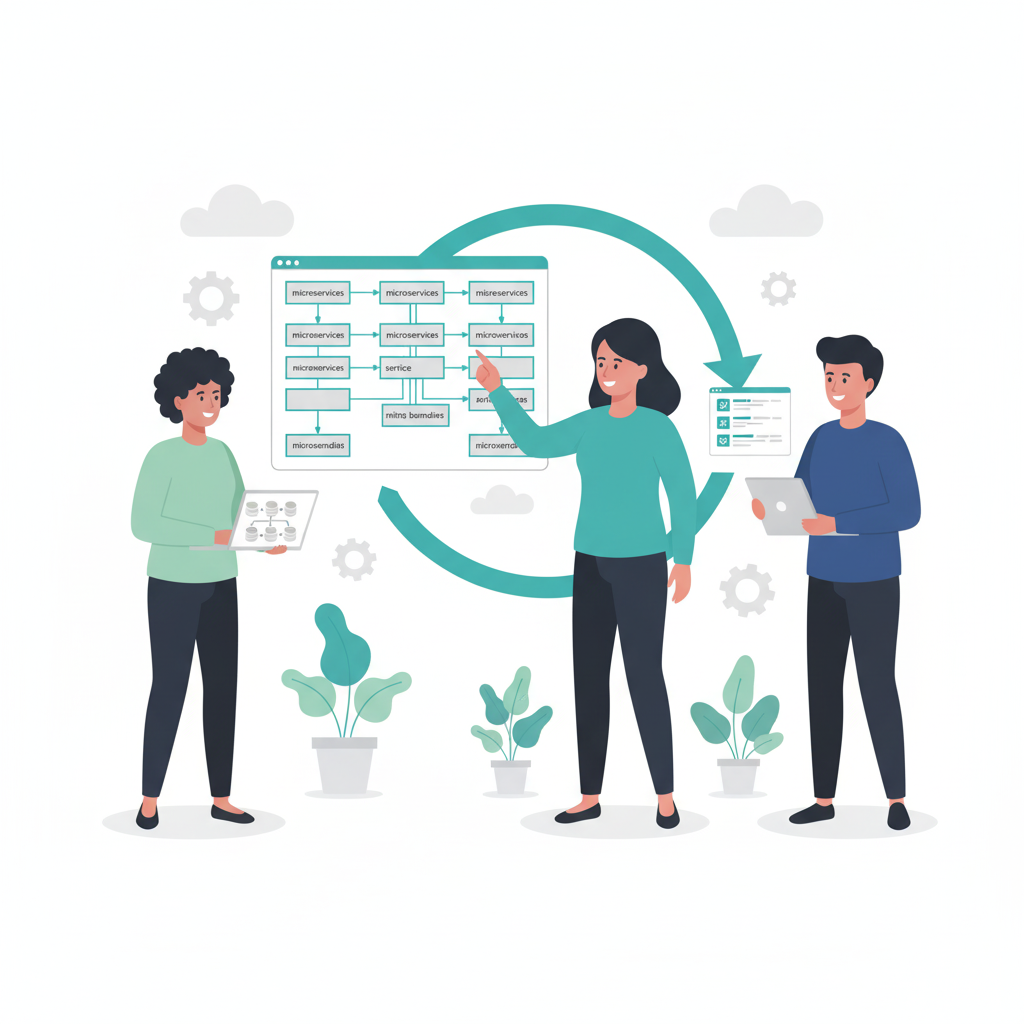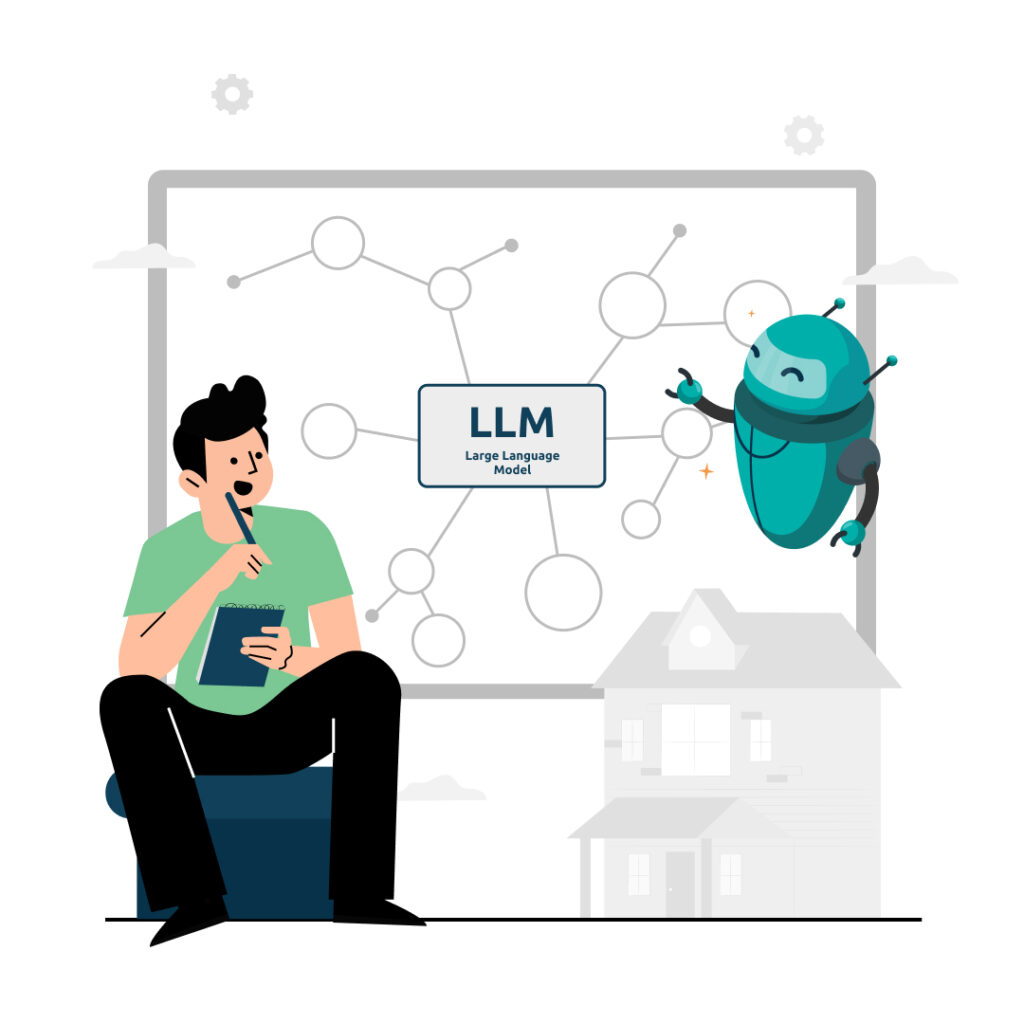Legacy systems constrain business agility, but full replacement is risky and expensive. Microservices architecture offers a strategic path forward through incremental decomposition, enabling organisations to modernise systematically while maintaining operational stability.
This guide explores proven strategies for decomposing monolithic legacy systems into microservices, comparing approaches with modular monolith alternatives and providing frameworks for informed architectural decisions. It’s part of our comprehensive modernization guide covering all aspects of legacy system transformation.
How does microservices architecture help with legacy system decomposition?
Microservices architecture enables incremental legacy system modernisation by breaking monoliths into independent, deployable services. This approach reduces risk through gradual migration, allows teams to modernise specific business capabilities without affecting the entire system, and enables independent scaling and technology choices for each service component.
The strangler pattern provides an effective approach for this incremental modernisation. This pattern allows you to gradually replace sections of code and functionality without completely refactoring the entire application. You incrementally route traffic to new microservices while legacy components continue handling the remaining functionality. For detailed implementation guidance, see our strangler pattern implementation guide.
Legacy system modernisation through microservices involves breaking down large, monolithic applications into smaller, more manageable components or services. Each service can be developed, deployed, and scaled independently, allowing your team to focus modernisation efforts where they’ll have the most impact.
Different services can use different technologies and frameworks, such as maintaining .NET for most modules while integrating Python for generative AI features. When decomposition is approached methodically through business capability analysis, structured approaches help you identify natural separation points and reduce coupling between components. This systematic approach builds on the broader legacy system modernization and migration patterns framework we’ve established for enterprise transformation initiatives.
What is the difference between microservices and modular monolith approaches for legacy modernisation?
Microservices decompose systems into independently deployable services with separate databases, enabling maximum autonomy but requiring distributed systems expertise. Modular monoliths organise code into well-defined modules within a single deployment unit, providing better performance and simpler operations while maintaining some architectural benefits of separation.
Modular monoliths organise code into well-defined modules within a single deployment unit, offering better performance and simpler operations. Every module follows microservices principles, but operations are exposed and consumed as in-memory method calls rather than network requests.
Data consistency and transaction management differ substantially. Monoliths maintain strong consistency through traditional ACID transactions, while microservices must embrace eventual consistency patterns.
Teams under 20 developers, early-stage products with evolving requirements, and strong data consistency needs often benefit more from monolithic approaches. Conversely, large teams (30+ developers) and complex applications requiring independent scaling typically justify the additional complexity of microservices.
How do you identify service boundaries when decomposing legacy systems?
You should align service boundaries with business capabilities and data ownership patterns, using domain-driven design principles to identify bounded contexts. Analyse existing code modules, database table relationships, and team expertise areas. Look for natural seams where data flows are minimal and business logic is cohesive within potential service boundaries.
Domain-driven design provides a framework that can get you most of the way to a set of well-designed microservices. The approach involves defining bounded contexts for each domain, which sets clear limits for business features and scopes individual services.
Microservices should be designed around business capabilities, not horizontal layers such as data access or messaging. This means examining what your business actually does rather than how your current system is technically organised.
One of the main challenges of microservices is defining the boundaries of individual services. You need to balance cohesion within services against coupling between services.
Data ownership patterns provide insights for boundary identification. Look for database tables that are primarily owned and modified by specific business processes. Organising teams around bounded contexts achieves better alignment between software architecture and organisational structure.
What API design principles apply to legacy system decomposition?
When decomposing legacy systems, you need API-first design with backward compatibility, versioning strategies, and gradual interface evolution. Design APIs that encapsulate business capabilities, provide clear contracts between services, and support both synchronous and asynchronous communication patterns.
Services communicate through well-designed APIs that should model the domain, not the internal implementation of the service. This abstraction allows you to evolve the underlying implementation without breaking dependent services.
Updates to a service must not break services that depend on it, requiring careful design for backward compatibility. Approximately 47% of development teams struggle with backward compatibility during updates, making semantic versioning essential.
API facades serve as effective transition mechanisms. These facades act as interception points, routing requests to either the legacy system or new microservices based on specific functionality.
API gateways act as a single entry point for all clients, routing requests to the appropriate microservice and handling authentication, rate limiting, and monitoring.
How do you handle database modernisation in microservices migration?
Database modernisation requires transitioning from shared databases to database-per-service patterns through careful schema decomposition and data consistency planning. Use event-driven patterns, saga transactions, and incremental data migration techniques. Plan for eventual consistency and implement proper data synchronisation mechanisms during the transition period.
The database-per-service pattern assigns each microservice its own exclusive database to promote decentralised data management. This pattern ensures that each microservice’s persistent data remains private to that service and accessible only via its API.
Private-tables-per-service, schema-per-service, and database-server-per-service represent different approaches to keeping service data private. The choice depends on your organisation’s operational capabilities and migration timeline.
Different services have different data storage requirements – some need relational databases while others might need NoSQL or graph databases. You must deploy another pattern to implement queries that span multiple microservices, such as API composition or CQRS patterns.
Use eventual consistency patterns, distributed transactions, SAGA pattern, and event sourcing for data management across services. These patterns enable better scalability and availability than traditional ACID transactions.
What are the key decomposition patterns for breaking monoliths into microservices?
The strangler pattern enables gradual replacement by incrementally routing traffic to new services while legacy components handle remaining functionality. Additional patterns include database decomposition, API gateway implementation, and bounded context extraction. Use parallel run strategies to validate new services before complete migration.
The pattern incrementally builds new functionality until the legacy system can be decommissioned. This approach provides less risk and delivers benefits along the way while maintaining the old system as fallback.
Use an API gateway or proxy to intercept calls and route to either old or new functionality conditionally. Begin with a comprehensive assessment of the legacy system to understand architecture, dependencies, and vital functionalities.
Parallel run strategies provide validation during transition periods by running new and old implementations simultaneously for comparison.
How does Conway’s Law affect microservices team organisation?
Conway’s Law states that system architecture mirrors organisational communication patterns, making team structure important for microservices success. Organise cross-functional teams around service boundaries, ensure teams have end-to-end ownership, and align communication channels with desired service interfaces.
Conway’s Law states that any organisation designing a system will produce a design whose structure is a copy of the organisation’s communication structure. This principle has profound implications because organisational structure directly influences architectural outcomes.
Teams organised by software layer lead to dominant layered structures, creating communication overhead and reducing development velocity. The microservice approach splits services organised around business capability with cross-functional teams including the full range of required skills.
The Inverse Conway Maneuver deliberately alters the development team’s organisation structure to encourage the desired software architecture. Teams are structured around business domains, owning the entire lifecycle of a service from development and testing to deployment and maintenance.
When should you use external consultants vs in-house teams for microservices implementation?
Use external consultants for initial assessment, architecture design, and knowledge transfer when internal teams lack microservices experience. In-house teams should handle ongoing development and operations after gaining sufficient expertise. Consider hybrid approaches where consultants mentor internal teams during implementation to build long-term organisational capability.
Microservices are highly distributed systems requiring careful evaluation of whether the team has the skills and experience to be successful. The complexity of distributed systems, API design, and operational concerns requires expertise that many teams lack initially.
Many development teams have found microservices to be a superior approach to monolithic architecture, but other teams have found them to be a productivity-sapping burden. This variation often relates to team maturity and implementation approach.
Individual teams should be responsible for designing and building services end to end, avoiding sharing code or data schemas. Building this capability internally ensures sustainable operations.
Avoid implementing microservices without a deep understanding of the business domain as it results in poorly aligned service boundaries. Internal teams typically have superior domain knowledge, while external consultants bring technical expertise.
FAQ Section
What tools help identify microservice boundaries in legacy code?
Tools like vFunction provide AI-powered analysis of code dependencies and data flows. AWS Application Discovery Service offers assessment capabilities, while static analysis tools can identify coupling patterns and potential service boundaries.
How long does it take to decompose a legacy system into microservices?
Timeline varies based on system complexity, team size, and decomposition approach. Typical enterprise decompositions take 12-24 months for incremental approaches, with initial services deployed within 3-6 months.
What are the biggest challenges when moving from monolith to microservices?
Key challenges include data consistency management, distributed system complexity, service boundary identification, team reorganisation, operational overhead, and maintaining system performance during migration.
How do you handle data consistency across microservices?
Implement eventual consistency patterns using event-driven architecture, saga patterns for distributed transactions, and careful service boundary design to minimise cross-service data dependencies.
What skills does my team need for microservices implementation?
Teams need distributed systems knowledge, API design expertise, database management skills, DevOps capabilities, monitoring and observability experience, and understanding of domain-driven design principles.
How do you break apart a shared database for microservices?
Use database decomposition strategies including schema separation, data ownership assignment, event-driven synchronisation, and gradual migration with dual-write patterns during transition periods.
What’s the best way to test microservices during decomposition?
Implement contract testing between services, maintain end-to-end test suites, use consumer-driven contracts, and establish comprehensive monitoring and observability across service boundaries.
How do you manage configuration and secrets across multiple microservices?
Use centralised configuration management tools, implement proper secret rotation, maintain environment-specific configurations, and ensure secure service-to-service authentication mechanisms.
What monitoring strategies work best for distributed microservices systems?
Implement distributed tracing, centralised logging, service mesh observability, health check endpoints, circuit breaker patterns, and comprehensive metrics collection across all service boundaries.
How do you handle backward compatibility during microservices migration?
Design APIs with versioning support, maintain facade patterns for legacy integrations, implement gradual feature migration, and use feature flags to control rollout of new service implementations.
Conclusion
Microservices architecture provides a strategic approach to legacy system modernisation through incremental decomposition rather than risky big-bang rewrites. Success depends on careful service boundary identification using domain-driven design principles, thoughtful database modernisation strategies, and team organisation that aligns with Conway’s Law.
The choice between microservices and modular monoliths should reflect your team size, system complexity, and operational capabilities. Smaller teams often benefit from modular monolith approaches, while larger organisations with complex scaling requirements justify the additional complexity of microservices. For a complete overview of all modernization patterns and decision frameworks, consult our comprehensive guide to legacy system modernization.
Implementation success requires balancing technical architecture decisions with organisational readiness. Whether using external consultants or in-house teams, focus on building long-term capability while following proven patterns like the strangler pattern for gradual migration. This comprehensive approach to microservices decomposition integrates with broader legacy system modernization patterns to ensure sustainable transformation outcomes.












